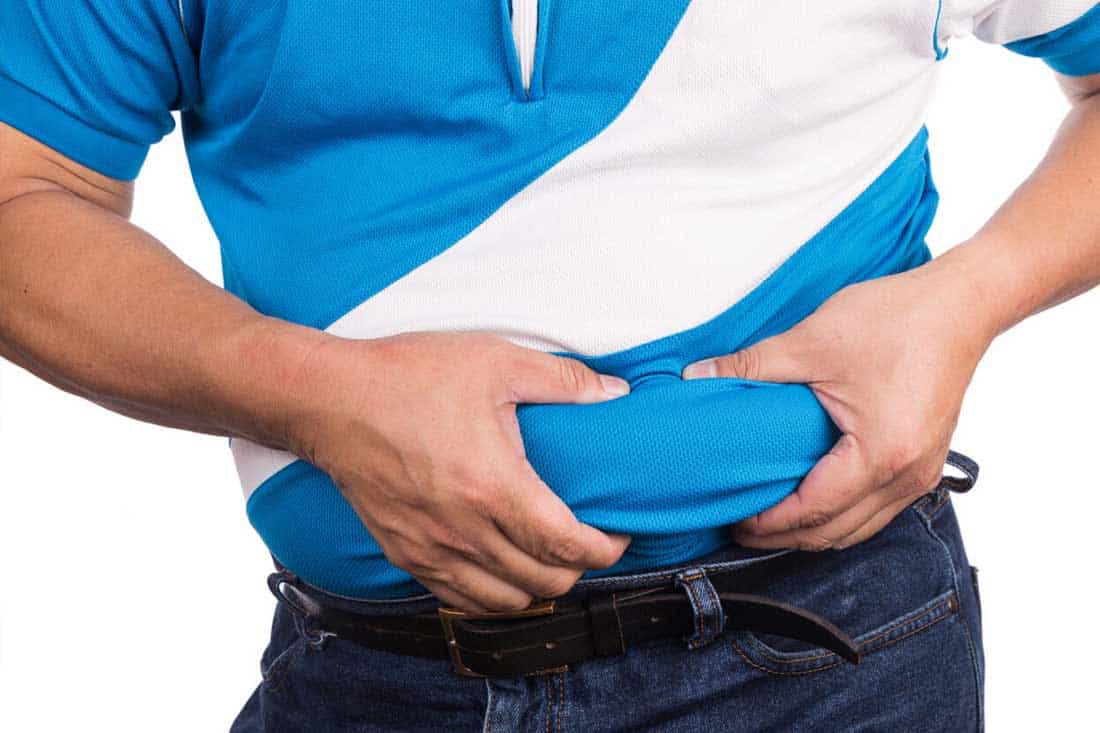Have You Heard of Visceral Fat?
Most people might comment you have a fatty side but what they never realize is that you are storing energy in the form of fat. But excess of it, is not something that you really want. The most common among all kinds of fat is the visceral fat.
What is Visceral Fat?
Like the common fat, visceral fat is located (i.e. stored) in the abdominal area and is even stored all around some of the major internal organs like intestines, pancreas, and liver. Sometimes the visceral fat is also called as ‘active fat’ as there are researches which show that such kind of fat plays a great distinct and dangerous role in affecting the functions of your body’s hormones.
In addition, storing huge amount of visceral fat is quite risky and dangerous as it is often associated with the increase risk of getting various health problems type 2 diabetes.
Kind or Type of Fat to Store
Now it is necessary to define the difference between the subcutaneous and visceral fat. The subcutaneous fat is a normal fat which is stored under our human skin and is the most common fat which we might feel in our legs and arms. Subcutaneous fat is one that results in growing the mid-section and constitutes visceral fat.
Frankly, the fat which we feel under our skin is called subcutaneous fat however, sometimes we might store a great amount of extra fat within our abdomen where our organs are located. Keep in mind that the intra-abdominal fat is the visceral fat which is resistant to insulin.
Insulin Resistance of The Visceral Fat
Do you know that having a huge amount of visceral fat is risky? If you have a lot of visceral fat, then it will lead to insulin resistance and this can easily lead to glucose intolerance and sometimes even to type 2 diabetes. Various medical studies show that visceral fat will secrete a huge amount of protein which is known as retinol-binding protein 4 (RBP4) and this increases the resistance one has to insulin.
Causes of Visceral Fat
A heavy diet filled with carbohydrate, chronic stress, and inflammation can sometimes lead to excess amount of visceral fat. Of course, a poor diet is a building block of stress that will easily amplify the rate for activating of the neurotransmitter NPY and even the cortisol hormone. Such signals show the body’s sympathetic ‘fight or fight’ response. This will trigger the need for storing more amounts of visceral fat.
In addition, hormones and genetics will easily influence on how the body will store this fat and this even includes the ratio of the subcutaneous to the visceral fat which is stored in the body. There are various studies which the cortisol (which is nothing but your stress hormone) and insulin will lead to an increase of visceral fat. However, the healthy amount of growth hormone along with sex hormone will simply prevent it.
Complications Involved in Visceral Fat
As soon as the visceral fat is accumulated, it will lead to health issues. Sometimes there are chances of it increasing the resistance of insulin and even can lead to prediabetes and diabetes. Various medical studies show that this can sometimes be due to retinol-binding protein which can easily increase the resistance of insulin which this kind of fat secretes. Sometimes there are chances of visceral fat increasing the blood pressure immediately.
In addition, there is a great possibility that excess of visceral fat will simply increase the risk of having various long term and life-threatening medical conditions. Some of these severe medical conditions are –
- Type 2 Diabetes
- Heart Attack and Heart Disease
- Breast Cancer
- Stroke
- Alzheimer’s Disease
- Colorectal Cancer
Rating Visceral Fat
Computed Tomography (CT) which is also called as imaging scans or MRI (Magnetic Resonance Imaging) are one of the most correct and easiest method of finding out if someone has accumulated visceral fat. But since conducting such type of scan is time-consuming as well as expensive, it might be better if you consult a doctor, as he or she can easily diagnose the visceral fat through asking questions related to lifestyle and diet. In addition, the doctor will even measure the overall body fat of the individual to have a fair idea of what percentage or amount of visceral fat an individual should be.
Various studies show that about ten percent of an individual’s total body fat consist of visceral fat. There is another useful and easy method of finding out the amount of visceral fat a person has which is by measuring the size of one’s waist. For women who have their waist measuring to about 35 inches or more will be having excess amount of visceral fat and this will indeed increase the risk of getting health problems related to visceral fat. This is same for men whose waist measure at 40 inches or more.
Now if a medical practitioner uses a body fat analyzer or MRI scan for measuring the visceral fat of an individual, then the result will be somewhere between the scale of 1 to 59. The visceral fat level must be under 13 on most scale. Keep in mind that anything which is more than 13 in such a scale would mean that the person really needs to make quick changes to their lifestyle as well as their diet. By making such changes, one can easily reduce the visceral fat levels to a healthier number.
How to Find Out If You Have Too Much Visceral Fat?
The most prominent method of finding out if you are storing excess amount of visceral fat is by undergoing an Magnetic Resonance Imaging Scan (MRI). But you really know that MRI scans aren’t that cheap and is not a recommended one or the best diagnosis tool for people suffering from diabetes. One of the best indicators for visceral fat is by taking the waistline measurement.
As per the Harvard University, about ten percent of the entire fat is stored as visceral fat and if you are having more amount of body fat than required, then it means that you are storing visceral fat which isn’t healthy. There are various researches which show that the size of one’s belly is the basic and most reliable indicator of the health risks involved and linked to visceral fat.
Getting Rid of Visceral Fat
There are extreme dangers involved in storing excess visceral fat. Not only is it extreme but also necessary for you to make changes to your lifestyle and diet as soon as possible. Frankly, losing weight is the best option for reducing the visceral fat.
Some of the major methods are –
Exercise
One of the best ways to reduce the visceral fat is exercising. It is important that you include cardiovascular exercises which can easily raise the heart rate of a person. Also try to include strength training which improves one’s muscle size into your day-to-day exercise routine.
Cardio vascular exercises consist of –
- Cycling
- Running
- Swimming
- Circuit Training
- Aerobics
Now your strength training can even consist of-
- Weights
- Squats
- Push ups
Stress
You might be surprised to know that stress plays a great role in storing excess amount of visceral fat. Now when a person gets stressed, their body releases the hormone called cortisol. This is the major factor that increases the visceral fat of an individual. Most doctors recommend that people who have high amount of visceral fat must reduce their stress levels.
Try to go for relaxation techniques like deep breathing, meditation, and other stress managing methods. Not only they can be beneficial for your body, but it also helps in reducing the visceral fat.
Diet
A good diet which is low in sugar and fatty food will easily help an individual in losing weight and removing the excess amount of visceral fat. Now it is important that your healthy diet must consist of the following –
- Fruits and vegetables
- Lean proteins
- Grilled, boiled, baked and steamed food which easily help in making your meals healthier and thus lowering the fat
- Food items containing complex carbohydrates like whole grains, sweet potatoes and beans.
Intermittent Fasting
Various medical and scientific studies show that intermittent fasting which is nothing but cycling out of the periods of eating and avoiding eating, will easily benefit your body as well as your brain. The same can be for lowering the visceral fat and increasing the adiponectic levels in your body for restoring the insulin sensitivity.
Just imagine, in 6 to 24 weeks, individuals who are following intermittent fasting diet will easily lose about 4% to 7% of their visceral fat. See how simple and easy it is.
HIIT(High Intensity Interval Training) Workouts
It might surprise you that HIIT workouts can easily strike a perfect balance among aerobic and resistance training. It simply provides you with fat-blasting benefits and that too in a short time. HIIT workout can be cycled among the burst of intense, periods of quick and all-out effort, recovery (which is think interval for walking and sprinting) and active exercises.
This means that such kind of training will easily help in burning fat and develop muscles faster compared to the traditional workouts. Besides that, it improves the insulin sensitivity and increases one’s resting metabolism, which in turn helps in keeping the body in fat burning state for a longer period. Also, various studies show that a modification in one’s lifestyle can lead to losing weight and achieving the preferred target for throwing away the visceral fat, thereby shedding the extra pounds which matter the most.
Being Motivated and staying On Track
If you expect weight loss to happen over overnight, then you are wrong. It takes a lot of time and is a bit of time consuming. According to various research studies and medical theories, a modest amount of weight loss will improve one’s visceral fat stores and even other kinds of medical complications that one has.
It is important that you use this motivation for sticking to exercise and proper eating program. By tracking your meal and logging the day to day progress on an app or journal will be the best method for losing the visceral fat. In addition, you can even reach out to supportive family members and friends and even ask them to encourage you on your journey to weight-loss. Various studies show that people who keep individuals accountable for something can easily reach their goals.
Going for Healthy Lifestyle Habits
For improving one’s overall health, you need to follow certain procedures like to stop drinking, smoking, being inactive and avoid consuming high amount of fat processed food stuffs. No doubt, by going for a healthier lifestyle, you can easily improve your quality of life and will even reduce the extra inches and become fit. Also, you even need to make sure that you have the required amount of sleep to remove unwanted stress. Various researches have shown that stress hormone like cortisol will easily help in increasing the storage of visceral fat. So, you really need to do some yoga or deep breathing exercise or go for a walk or to distress yourself.
Seeing A Doctor
An individual who has a waistline that measures to about 40 inches or more and women whose waist line is 35 inches, or more are the ones who have a huge storage of visceral fat.
The doctor will diagnose and even explain the potential risk involved. They will even provide the required advice on how to make your life healthier and what kind of changes you need to do to your lifestyle to lower the visceral fat. Have a holistic approach towards this as there are a lot of factors involved. It is a huge mind set shift so start small and work our way up. No one said it is going to be easy but the effort will be rewarding at the end.




